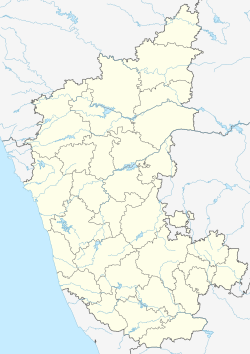| Kollur Mookambika Temple | |
|---|---|
 Inside view of the Kollur Mookambika temple | |
| Religion | |
| Affiliation | Hinduism |
| District | Udupi |
| Deity | Mookambika |
| Festivals | Rathotsava, Navaratri, Vijaya Dashami |
| Location | |
| Location | Byndoor |
| State | Karnataka |
| Country | |
| Coordinates | 13°51′50″N74°48′52″E / 13.8638°N 74.8145°E |
| Architecture | |
| Type | A mix of different styles, such as Dravidian, Chera, Vijayanagara, and Hoysala |
| Creator | King Halugallu Veera Sangayya |
| Completed | ~800 CE |



Kollur Mookambika Temple is located at Kollur in Byndoor Taluk of Udupi District in the state of Karnataka, Tulunadu region, India. It is a Hindu temple dedicated to the mother goddess Mookambika. Mookambika and Kodachadri have traditionally been regarded as important centres of sakthi worship in North Malabar, sometimes described as the “headquarters of Shaktism” of North Malabar, particularly between Thalassery and Vadakara. Adi Shankara is believed to have visited the self-manifested swayambhu lingam known as the Mithuna Lingam, which is distinguished by a golden line at its centre, symbolising a predominance of the Shakti aspect over the Shiva aspect. The current idol of the goddess is said to have been installed in the posture in which she is believed to have appeared before him, worshipping the lingam. [1]
Contents
Mookambika is the union of Adipara Shakthi and Parabramha as the Linga has integrated on its left side "Maha Kali, Maha Lakshmi and Maha Saraswathi". [2] [3] [4] [5] [6]
According to the legend, after a long meditation at Kodachadri Hills, Mookambika devi appeared before Adi Shankara and he invited Mookambika devi to be consecrated in Chera territory (present day North Kerala) so that the Malayali people could worship her. The goddess agreed on the condition that she would follow behind him as he walked, but he must never look back; if he did, she would remain at the spot where he turned. Shankara consented, and they began the journey after crossing the Sowparnika River. At one point, when he could no longer hear the sound of the goddess’s anklets, he turned to look, whereupon she halted and declared that she would remain there permanently, assuring that Malayalis from the Chera land who came to see her would be blessed. The place later developed into the Mookambika Temple. Until the Karnataka government assumed control of the temple administration in the 2005s, its management had traditionally carried out by a trust consisting of Malayali devotee families from North Malabar, notably certain Thiyyar tharavads like Manappalli from Iringal and Vadakara. [7]
After the restructuring and takeover by the Karnataka government, the temple and its surroundings have undergone significant changes, driven in part by the growing number of devotees from Kerala contributing substantial funds. However, this has also led to challenges such as rapid commercialisation, poor waste management, construction of bunds in Sauparnika river and pollution, with even untreated human waste reportedly flowing into the Souparnika River, the river that is central to the temple’s identity and rituals. In addition, unregulated building construction has caused environmental degradation, posing threats to both the forest ecosystem and the temple itself, in contrast to the more regulated approaches followed in some Western countries. [8]
The Temple offers salam mangalarathi , also known as pradosha pooje at 7.30pm daily to Tipu Sultan. [9]
